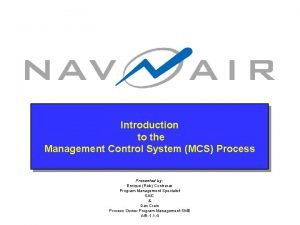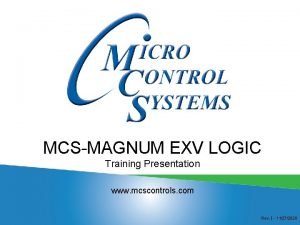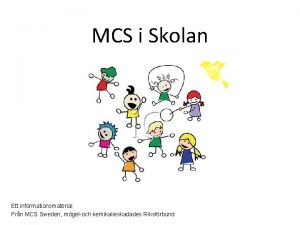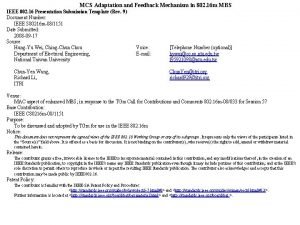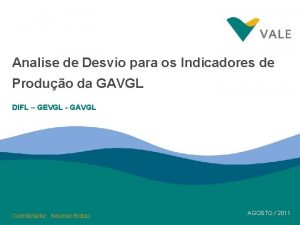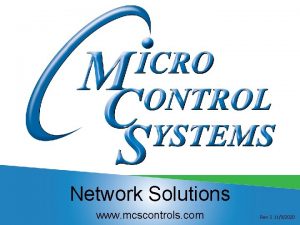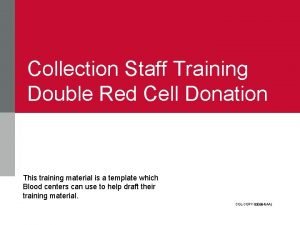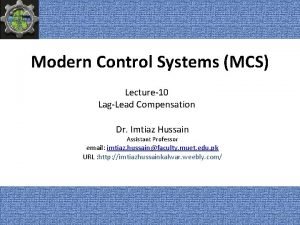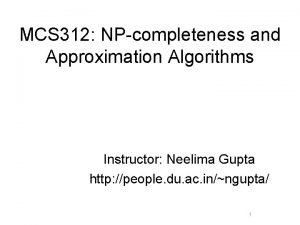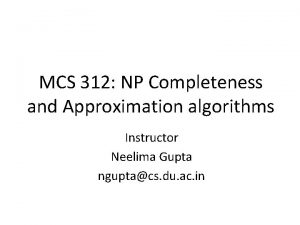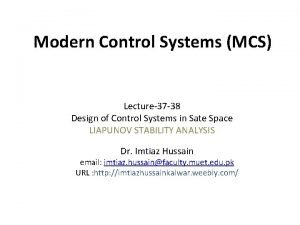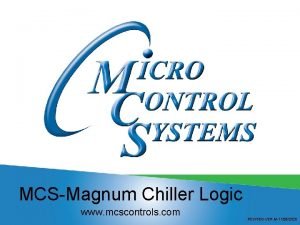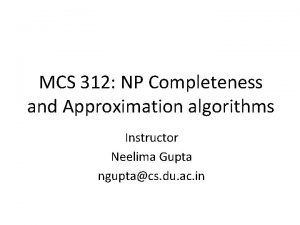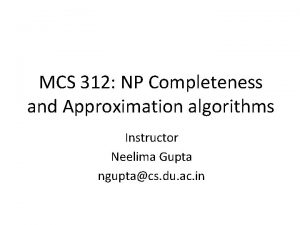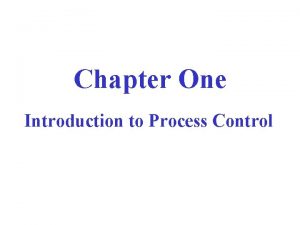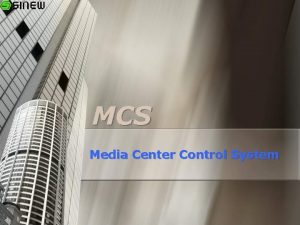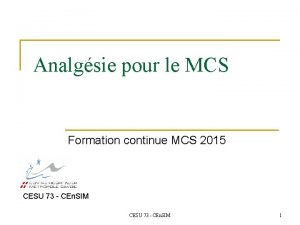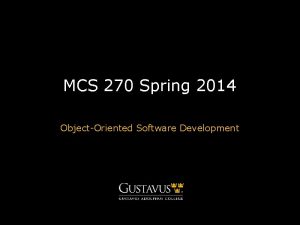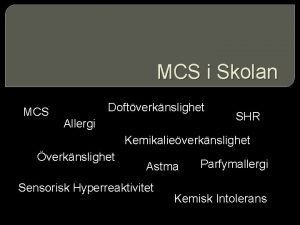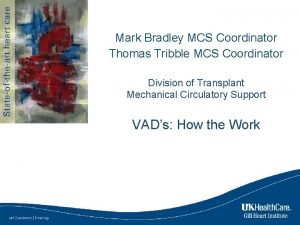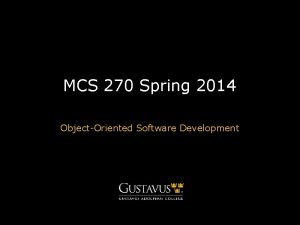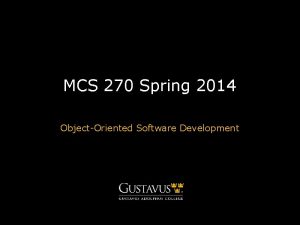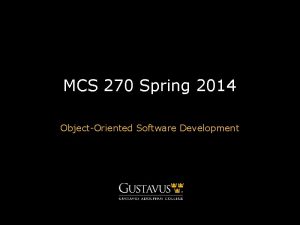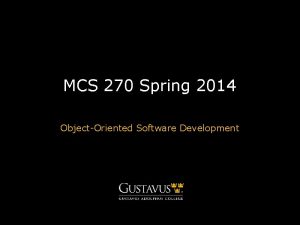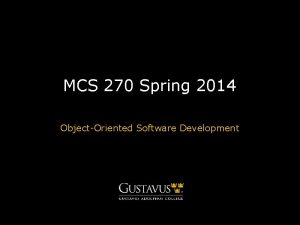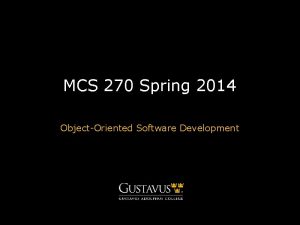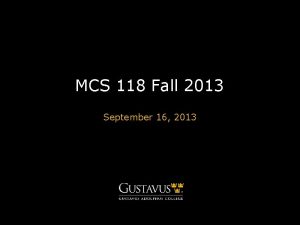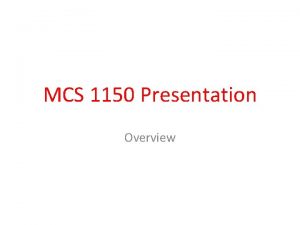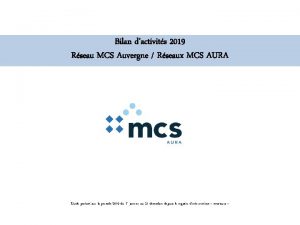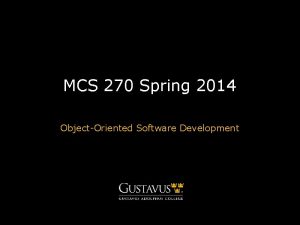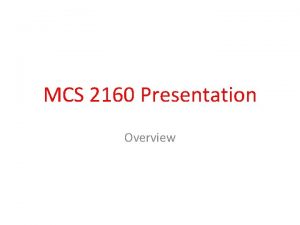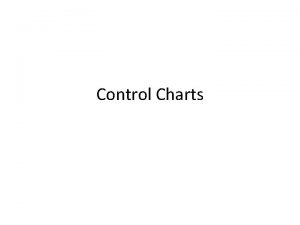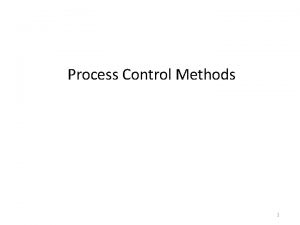Introduction to the Management Control System MCS Process





















- Slides: 21

Introduction to the Management Control System (MCS) Process Presented by: Enrique (Rick) Contreras Program Management Specialist SAIC & Dan Crain Process Owner Program Management SME AIR-1. 1. 4

Topics n What is the MCS? n Origin of MCS n MCS Relationship to Government/Industry Standards n Benefits of the MCS n Barriers to Success n Status of the Process 2 Return to Topics Page

What is the MCS? 3 Return to Topics Page

SIGMA and MCS Functions WBS Dictionary (Technical SOW) Contract Management Performance Measurement Baseline Maintenance Project or Technical Management Information Management Work Breakdown Structure Integrated Master Schedules Finance & Accounting Management SIGMA is a collection of business processes defining functions within NAVAIR. These processes are not fully integrated nor do they address project management. In past systems, this data was held in separate and non-integrated tools. SIGMA now provides NAVAIR with an integrated tool. 4 Organization Breakdown Structure Baseline Management Funding Sources & Appropriation Types The MCS integrates the business functions into the project management process. Establishing criteria and the basis for sound project management and controls is the development of the cost, schedule & technical baseline data. Return to Topics Page

An Integrated Process The MCS is the primary process within NAVAIR for in-house project management. n The MCS is an integrated project management process consisting of inter-related subsystems used to manage projects with these objectives: n Application of integrated project management practices n Management of total project work scope n Manage by Exception n Use Earned Value to measure performance against a stable cost, schedule, & technical baseline The MCS establishes a “backbone” for integration of the SIGMA Business Function Processes into the project management process. 5 Return to Topics Page

Origin of MCS 6 Return to Topics Page

Origin n Began as a “System Description” n Process addressed application of EVMS for in-house work n SD&I written for SIGMA-based business rules n Required SAP specific descriptions, definitions, and instructions n Evolved into an IMP document, EVMS became a secondary goal for MCS n Training had to address “cultural” barriers of Project Management vs. Funds Management philosophy 7 Return to Topics Page

MCS Relationship to Government/Industry Standards 8 Return to Topics Page

The MCS Process Flow n The MCS process flow follows the EVMS process flow n This consists of five major phases, containing 10 steps n Implementation, Training and Execution also follow this flow Monitor: Organize: 1. Define the Work 6. Perform the Work 2. Assign the Work 7. Measure the Work 8. Forecast Remaining Work Authorize: 3. Authorize the Work Plan: 9 4. Schedule the Work 5. Budget the Work & Negotiate the Baseline Control: 9. Analyze Variances & Take Corrective Actions 10. Revise the Baseline (as Necessary & Permitted) Return to Topics Page

Basis for the NAVAIR MCS Process Government & Industry Requirements Do. DD 5000. 1 & Do. DI 5000. 2 NAVAIR Management Control System (MCS) Process Document Earned Value Management Systems (EVMS) Guide EVMS ANSI Standard ANSI/EIA-748 -1998 PMI* Project Management Body of Knowledge (PMBOK) Process Instructions SIGMA Training & Scripts MCS Training & Implementation *Project Management Institute 10 Return to Topics Page Project-Specific Requirements Program Office Directive (POD) Statement of Work IMP/IMS

MCS & EVM: Relationships & Applicability Section 1 Project Definition & Organization MCS Section 2 Project Planning, Budgeting, & Authorization Sections 3 - 7 Project Execution, Sustainment, and Surveillance Monitor: Authorize: Organize: EVM 6. Perform the Work 3. Authorize the Work 1. Define the Work 2. Assign the Work 7. Measure the Work 8. Forecast Remaining Work Plan: Control: 4. Schedule the Work 9. Analyze Variances & Corrective Actions 10. Revise the Baseline 5. Budget Work & Negotiate Baseline Major Do. D Contracts n Definition: n Cost & Incentives contracts >$20 M (CPR & IMS Tailored) n Cost & Incentives contracts >$50 M (Certified EVMS, CPR & IMS) n Not mandatory for FFP, T&M contracts Less than Major Contracts n Threshold: n >$20 M Optional, Risk based PM Decision n >12 mo. , & >$6. 3 M, but < threshold for major contract n n Do. D NAVAIR Do. DD 5000. 1 & Do. DI 5000. 2 12 May 2003 Contract Performance Report (CPR) OMB Circular A-11, Preparing, Submitting, and Executing the Budget 27 June 2002 Earned Value Management Implementation Guide (EVMIG) 3 Oct 1997 Integrated Master Schedule (IMS) ANSI/EIA-7481998 Yes n Milestone Decision Authority (MDA) / Program Executive Offices (PEO) will be the decision maker for application of EVM principles and practices for in-house projects using the following criteria: n n MDA/PEO Assesses New Project 1 1 st Consideration: n >= 12 Months & >= $6 M? No Sufficient Risk? No Duration (12 months or greater) and Cost ($6. 3 M or greater) 2 nd Consideration: n 11 Formal Acceptance of Contractor’s EVM System Risk (Cost, Schedule, Technical) Return to Topics Page EVM Not Required Yes Decision to Apply EVM

Benefits of the MCS 12 Return to Topics Page

Why MCS? n To meet Sponsor & Organization objectives and requirements (cost, schedule, & technical) n To stay on schedule & budget n To stay (be) competitive n To practice “Project Management”, not “Funds Management” n The underlying concepts are sound & make good business sense n To comply to Industry-accepted processes and practices n Because the Government, Sponsor, or Boss says so! 13 Return to Topics Page

The Value of the MCS to Project Managers n Providing essential insight into questions such as: n What are the major deliverables & how are we performing against them? n What are the major pieces of the work scope & who is responsible? n What are the major issues & risks to watch out for? n What resources do we need to complete this project? n How far along are we? How much work has been accomplished? n What are we doing about problems? n What are the major changes since the project started? n To date, are we over or under-run? Ahead or behind schedule? n At completion, will the project be over or under-run? Ahead or behind schedule? n Historically, what have similar projects cost? How long have they taken? 14 Return to Topics Page

Benefits of the MCS n Combined with the use of SIGMA, NAVAIR establishes the use of a standard process and tool throughout the Command n Perform analysis on all Projects within a Program, Organization, and within NAVAIR n Allows for the management of ALL project works scope (Organic and Contracted) in one system n Establishes one set of criteria for project management, regardless of complexity, value, or duration of the project work scope n Drill down to see detail of Projects, WBS elements, & Control Accounts n Summarize Projects for HQ, Field Activities, etc. n Quickly see cost & schedule variances that provide “early warning signals” for projects n Ensure accurate Estimate-at-Completion (EAC) n Develop standard reports to assess common project management criteria across all projects within NAVAIR 15 Return to Topics Page

Live / Dynamic Data Access n “Real time” data n Weekly NAVAIR Labor Hours/Costs n Monthly Contractor Support Services (CSS)—as invoiced n External costs—as invoiced n Need to drill down to find answers to issues (Variances) n Takes more than one page to get a picture of the Project’s status n Good data depends on objective status (garbage in, garbage out) n Technical explanations or analysis require people’s inputs n Administrative effort still required 16 Return to Topics Page

Barriers to Success 17 Return to Topics Page

Obstacles to Overcome n Management Commitment n Process Discipline n Practice vs. Policy n Change n Cultural n Government vs. Industry Practice 18 Return to Topics Page

Status of the Process 19 Return to Topics Page

Ongoing Efforts n P-8 A MMA n PMA-213, JPALS n AIR-1. 0 Workload Planning & Staffing n SIGMA PS Business Rule Integration 20 Return to Topics Page

Future n MCS-based Project Management Training using NAVY ERP n Smaller, Controlled Audience n Project-specific Implementation Training and Support n Web-based MCS documents, training, templates and tools 21 Return to Topics Page
 Mcs controls training
Mcs controls training Exv driver
Exv driver Vad är mcs
Vad är mcs Feedback mcs
Feedback mcs Cisco prime collaboration deployment 12
Cisco prime collaboration deployment 12 Mcs motivo causa solução
Mcs motivo causa solução Mcs magnum controller
Mcs magnum controller Double red cell
Double red cell Jpams mcs
Jpams mcs Mcs weebly
Mcs weebly Linkit 7697 wifi
Linkit 7697 wifi Mcs ecampus
Mcs ecampus Mcs 312
Mcs 312 Mcs 312
Mcs 312 Mcs weebly
Mcs weebly Mcs magnum controller
Mcs magnum controller Mcs 312
Mcs 312 Mcs 312
Mcs 312 Product vs process
Product vs process Introduction to process control
Introduction to process control Digital control
Digital control Introduction to digital control system
Introduction to digital control system
